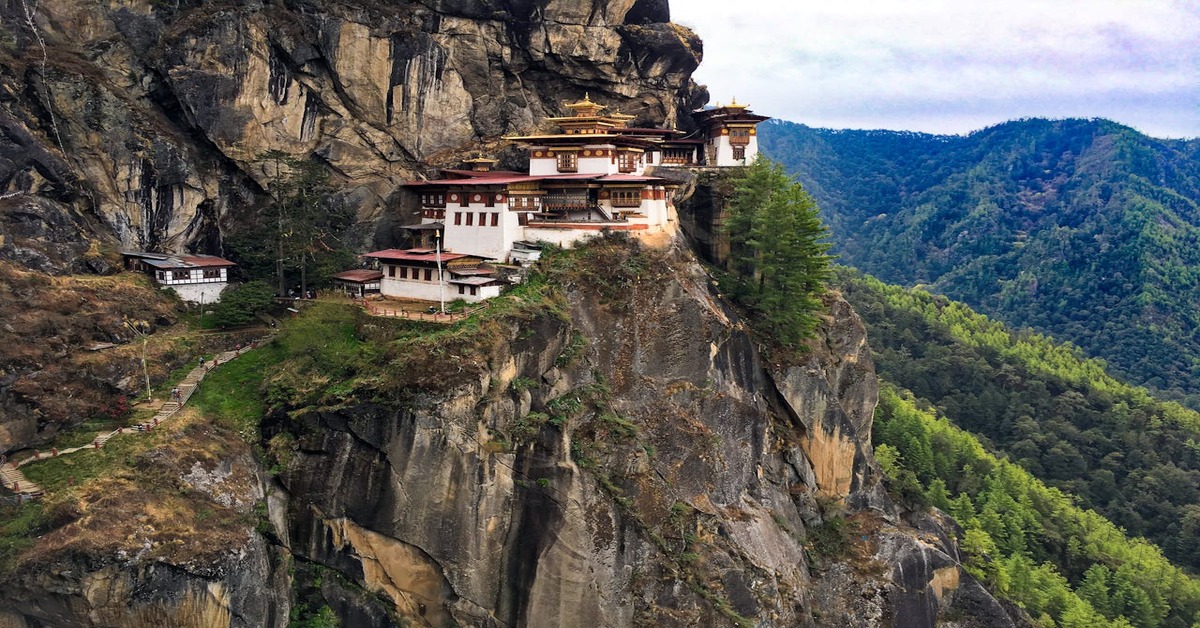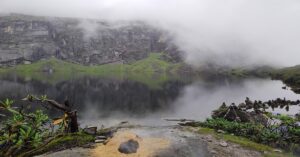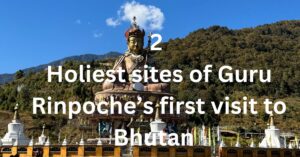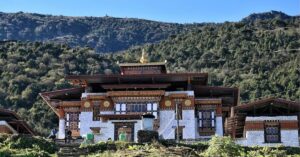Temples in Bhutan serve as spiritual sanctuaries and educational centers. Bhutan is rich in culture, spirituality, and Buddhist heritage. Among the most famous sites are Taktsang Monastery (Tiger’s Nest), Kurjey Temple, and Kyichu Lhakhang, each offering unique architecture and historical significance.
Many of Bhutan’s fortresses and monasteries, such as Punakha Dzong and Tango Monastery, are centuries old and hold historical and spiritual importance. Some were built to ward off evil spirits, while others propagate Buddhism. These temples, whether perched on cliffs or nestled in green valleys, provide visitors with serene spots for meditation and cultural immersion.
Also Read: Guru Rinpoche in Bhutan: His Visits to Bhutan and Sacred Sites
For those interested in Bhutan’s spiritual heritage, visiting these temples in Bhutan offers a profound experience, blending cultural discovery with peaceful retreats. A journey to Bhutan’s famous temples guarantees insight into its deep-rooted Buddhist traditions and mythical legacies.
Here are 10 Famous Temples in Bhutan:
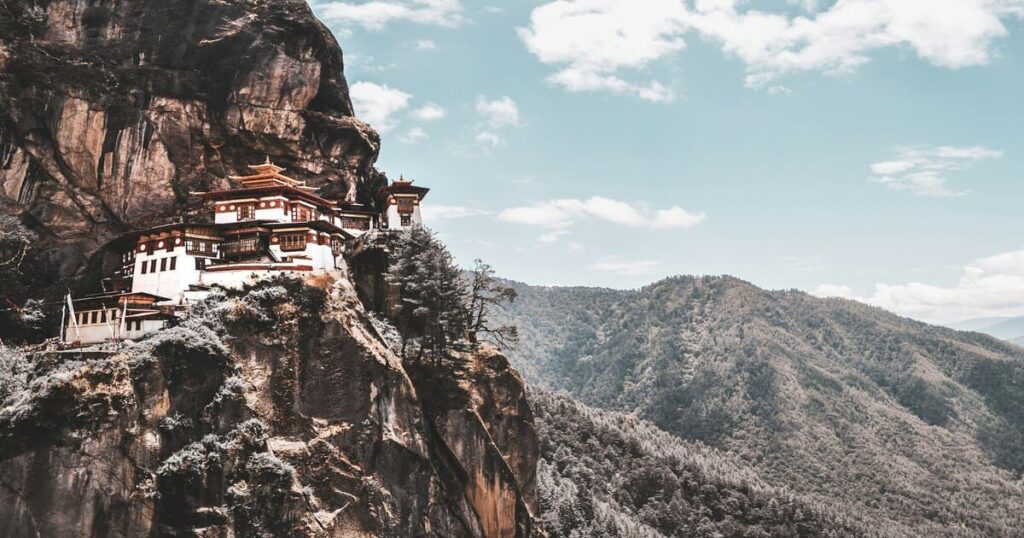
1. Taktsang Palphug Monastery (Tiger’s Nest), Paro
Paro Taktsang, also known as Tiger’s Nest, is one of the revered Buddhist temples in Bhutan, perched at 3,140 meters above the Paro Valley. It is famously associated with Guru Rinpoche, who is said to have meditated in a cave here for three years, three months, three weeks, and three days in the 8th century. The monastery was built in 1692 to honor this sacred site and is one of the holiest places in Bhutan.
Visitors can trek to Paro Taktsang via a scenic 4 km trail, which typically takes about three hours. The site features stunning architecture and several temples interconnected by staircases. Notably, it houses sacred relics and murals depicting the eight forms of Guru Rinpoche. The monastery is not only a pilgrimage destination but also offers breathtaking views of the surrounding landscape, making it a must-visit for travelers seeking spiritual and natural beauty.
Read More: Paro Taktsang, the Sacred Place of Guru Rinpoche’s Enlightened Mind
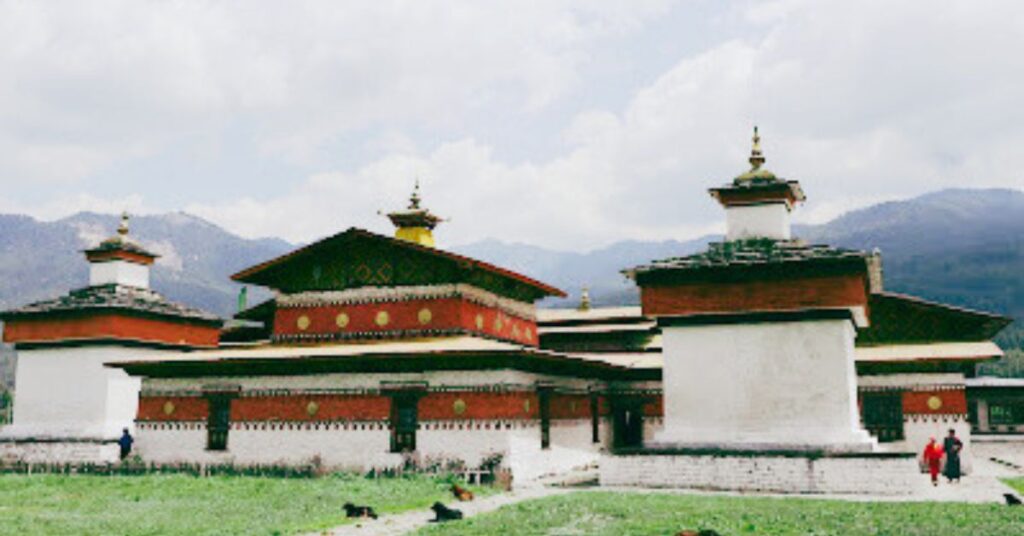
2. Jambay Lhakhang, Bumthang
Jambay Lhakhang, one of the oldest temples in Bhutan, was founded in 659 CE by King Songtsen Gampo as part of a mission to spread Buddhism and pin down a demoness obstructing its growth. Located in Bumthang at an elevation of 2630 meters, this single-story temple is dedicated to Jowo Jampa, the future Buddha. The temple’s historical significance is further enhanced by its blessing from Guru Rinpoche in the 8th century.
It is renowned for the Jambay Lhakhang Drup, an annual festival held in October, featuring vibrant masked dances and rituals like the Mewang fire blessing and Tercham naked dance. Visitors can explore various sacred relics and architectural features within the complex, making it a vital pilgrimage site that encapsulates Bhutan’s rich cultural heritage. The best times to visit are during spring and autumn, particularly to experience the festival.
Read More: Jambay Lhakhang, one of the Oldest Temples in Bhutan founded in 659 CE
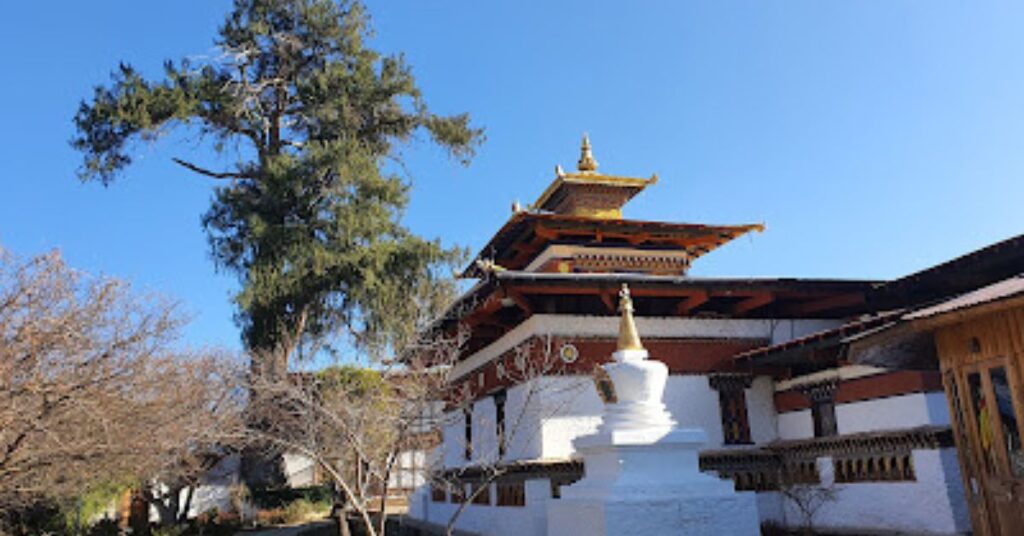
3. Kyichu Lhakhang, Paro
Kyichu Lhakhang, located in Paro, is also one of the oldest temples in Bhutan, founded in 659 CE by Tibetan King Songtsen Gampo. It was constructed as part of a mission to build 108 temples in a single day to subdue a demoness obstructing the spread of Buddhism. The temple complex features two main structures: the older Jowo Lhakhang and the newer Guru Lhakhang, built in the 19th century.
Visitors can see sacred relics, including a 7th-century statue of Jowo Sakyamuni and statues of Chenrezig and Guru Rinpoche. The temple is not only historically significant but also a site for annual rituals, such as the Kyichu Zangchoe Moenlam festival. Accessible by taxi or a scenic hike from Paro town, Kyichu Lhakhang is best visited in spring or autumn, offering a glimpse into Bhutan’s rich cultural heritage and spiritual legacy.
Read More: Kyichu Lhakhang, the Sacred Jewel of Bhutan
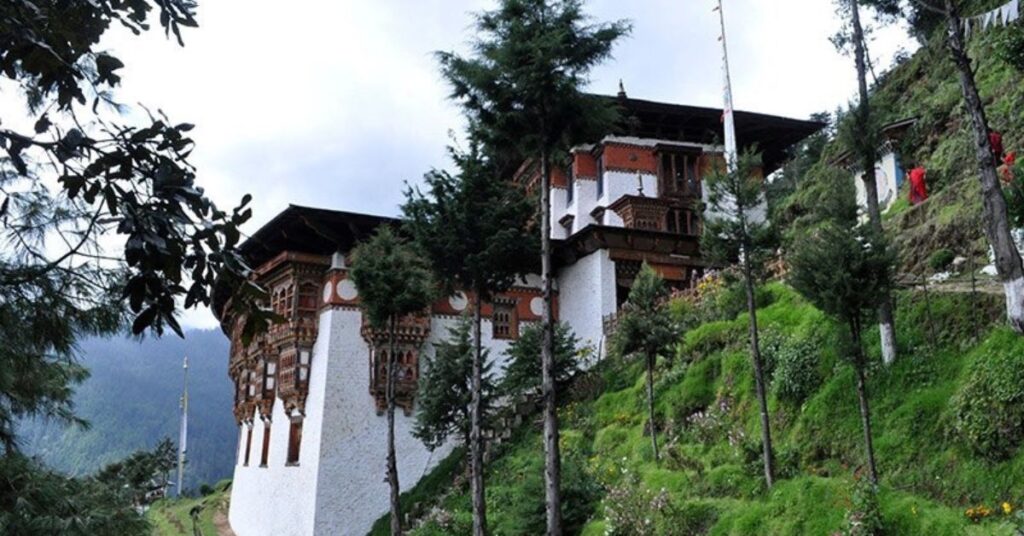
4. Tango Monastery, Thimphu
Tango Choying Dzong, a significant Buddhist monastery in Thimphu, Bhutan, was founded in the 13th century by Phajo Drugom Zhigpo. The site is revered for its historical and spiritual importance, notably as the place where Avalokiteshvara manifested as the wrathful Hayagriva. The monastery features a unique three-story structure built in 1688, with twelve corners and six major temples. It hosts the annual “Yarney” festival, during which monks observe a summer retreat.
Accessible via a scenic hike, the monastery offers stunning views and a rich biodiversity experience. Inside, visitors can find sacred relics, including a golden horse-head key and remarkable wall paintings from the 17th century. The best times to visit are spring and autumn, coinciding with pleasant weather and religious festivities. Tango Choying Dzong remains a vital center for meditation and Buddhist teachings in Bhutan.
Read More: Tango Choying Dzong, where Chenrizig revealed himself as “Wrathful Hayagriva”
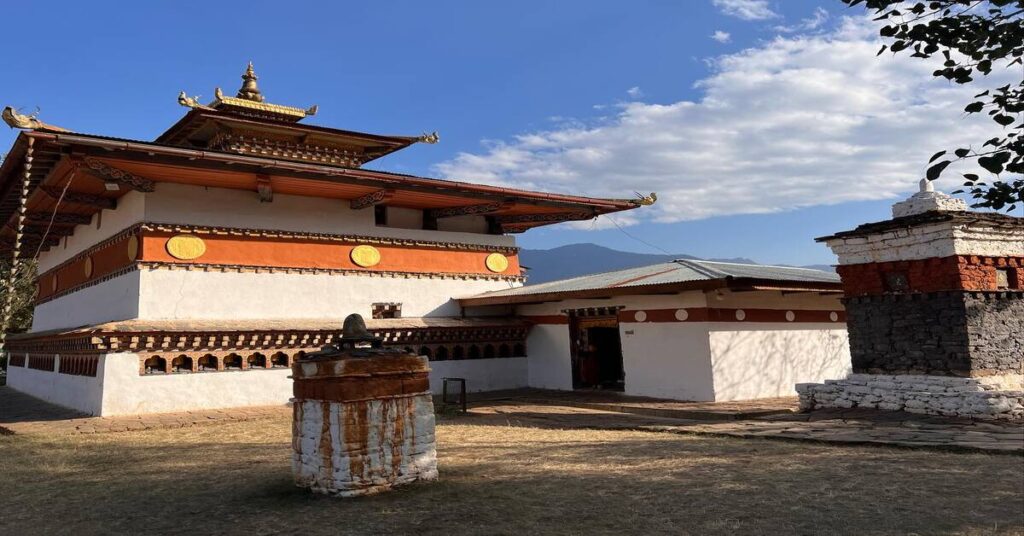
5. Chimi Lhakhang (Fertility Temple), Punakha
Chimi Lhakhang, located in Lobesa, is a renowned fertility temple in Bhutan built in 1499 by Lam Ngawang Chogyal in honor of Drukpa Kunley, known as the Divine Madman. The temple stands on a hill resembling a woman’s breast in Punakha and is famous for its unique fertility blessings, where couples seeking children are tapped on the head with a wooden phallus by a monk. The temple’s name, meaning “No Dog Temple,” stems from a legend where Drukpa Kunley subdued a demoness disguised as a dog.
Visitors can reach the temple via a short hike or a scenic walk through the rice fields. With its rich history, beautiful surroundings, and vibrant rituals—including the blessing ceremony and the sale of phallus-themed souvenirs—Chimi Lhakhang offers an engaging cultural experience and remains a significant pilgrimage site for couples worldwide. The best times to visit Chimi Lhakhang monastery are from March to May and September to November.
Read More: Chimi Lhakhang, the Fertility Temple of Divine Madman
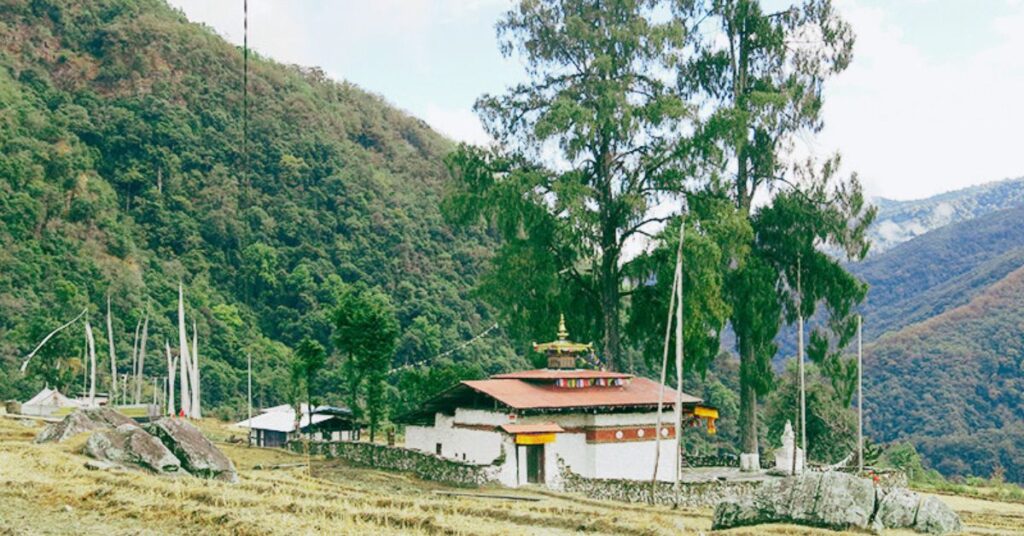
6. Nabji Lhakhang, Trongsa
Nabji Lhakhang is one of the significant one-storied temples in Bhutan, built by Khandro Tashi Khyidren at the site where Guru Rinpoche erected a stone pillar of oath to promote peace between two rival kings, Sindhu Raja and Nawoche. Located in Nabji village, Trongsa, the temple features relics including the stone pillar with handprints of the three figures, symbolizing harmony and spiritual teachings.
Visitors can reach Nabji by hiking from Nabji Primary School or via the Nabji Korphu trek, which showcases Bhutan’s rural beauty. The temple is rich in history, believed to have been blessed as a Beyul (hidden land) by Guru Rinpoche. An annual festival, the Nabji Lhakhang Drup, celebrates this heritage with traditional dances and rituals. The best time to visit is during this festival, held in the 11th month of the Bhutanese calendar, offering a vibrant cultural experience.
Read More: Nabji Lhakhang, a Place where Guru Rinpoche erected a Stone Pillar of Oath
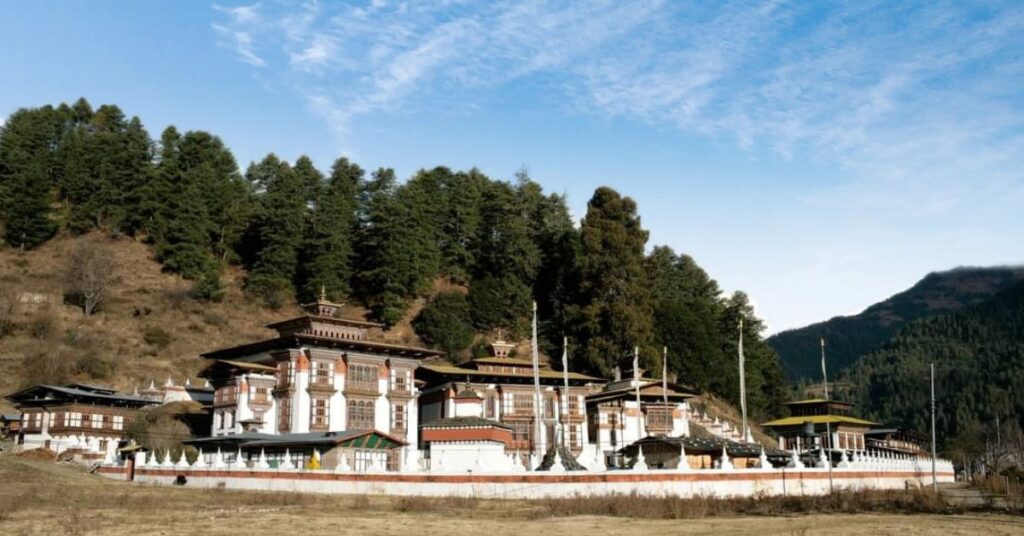
7. Kurjey Lhakhang, Bumthang
Kurjey Lhakhang, located in Bumthang, is one of the sacred temples in Bhutan, established in the 8th century by Guru Rinpoche. The name “Kurjey” translates to “body imprint,” referring to the sacred impression left by the Guru during his meditation in the cave of the Red Cliff, where he subdued the local deity Shelging Karpo. This site is revered for its historical and spiritual importance, as it marks the beginning of Vajrayana Buddhism in Bhutan.
The complex includes three main temples and various relics, such as the self-arisen body imprint of Guru Rinpoche and a cypress tree believed to have sprouted from his walking stick. Visitors can explore the meditation cave, witness intricate wood carvings, and experience the sacred waters known as Kurjey Drupchhu. Kurjey Lhakhang remains a vital destination for both local and international pilgrims seeking spiritual connection and healing.
Read More: Kurjey Lhakhang, a Cave where Guru Rinpoche left his Body Impression
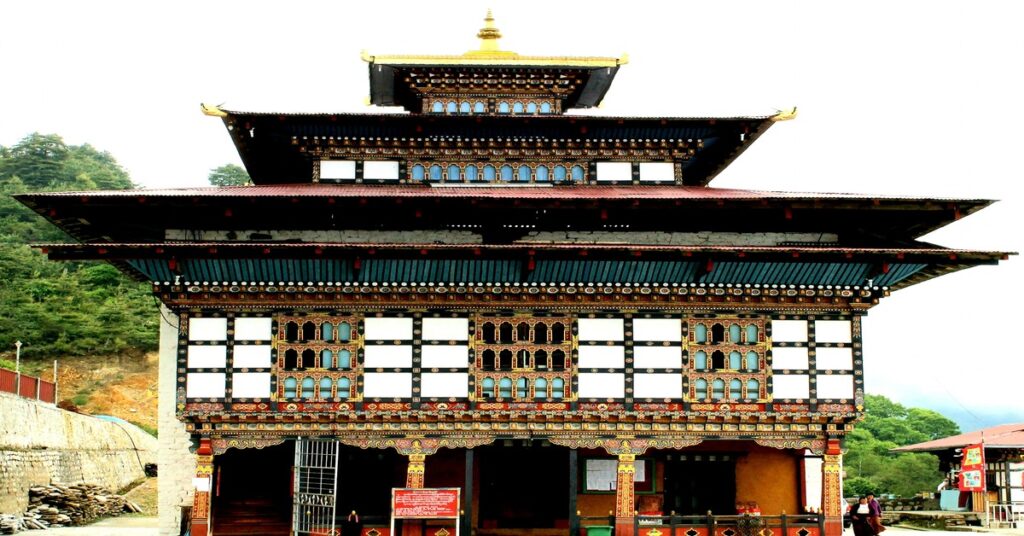
8. Chador Lhakhang, Trashigang
Chador Lhakhang, located in Bartsham Trashigang, is one of the revered temples in Bhutan for housing the thumb-sized Chador Statue, discovered in Yuetsho Lake by Pema Lingpa in the 15th century. The temple, originally built in the 12th century and renovated several times, was officially completed in 2019 under Dzongsar Jamyang Khyentse’s patronage. The Bartsham Chador Lhakhang is believed to grant wishes, protect against snake bites, and aid women seeking children. It features intricate wall paintings and significant relics, including a statue of Guru Rinpoche.
The Seldap Tshechu, a major festival held annually, showcases traditional masked dances and attracts many pilgrims. Visitors are encouraged to experience the temple’s spiritual ambiance during this vibrant celebration, making it an ideal time for pilgrimage. Chador Lhakhang stands as a testament to Bhutan’s rich spiritual heritage and cultural history.
Read More: Chador Lhakhang, a Temple renowned for the Statue of Chador, discovered from a Lake
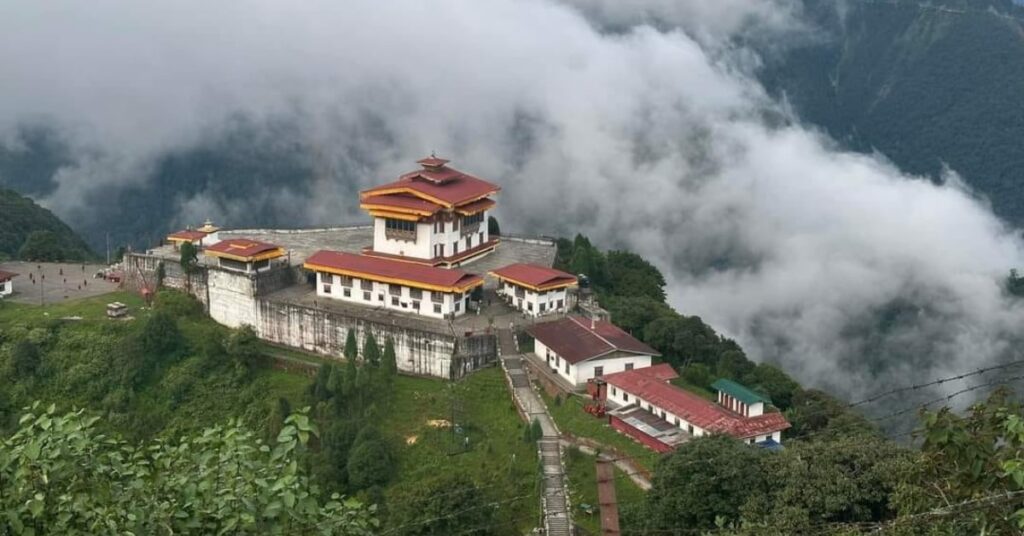
9. Yongla Goenpa, Pemagatshel
Yongla Goenpa, a revered monastery in Pemagatshel, was founded in 1736 by the second Yongla Lam, Dorji Jamtsho, to honor Kheydrup Jigme Kuendrel. Located on a mountaintop resembling a Phurba (ritual dagger), it overlooks the valleys of Samdrup Jongkhar. This sacred site has been blessed by numerous Buddhist luminaries and is historically significant, having served as a military base during the Duar War against British troops. The monastery features various sacred relics and deities, including thousands of Dorji Drolo statues.
The annual Yongla Phurbai Drubchen, initiated by Kheydrup Jigme Kuendrel, is a spiritual ritual aimed at strengthening Bhutan’s sovereignty. Although accessible year-round, the best time to visit is during this festival in September. After being damaged by an earthquake in 2009, Yongla Goenpa was restored to its former glory by 2019.
Read More: Yongla Goenpa, a Monastery on a Hill that Resembles a Phurba
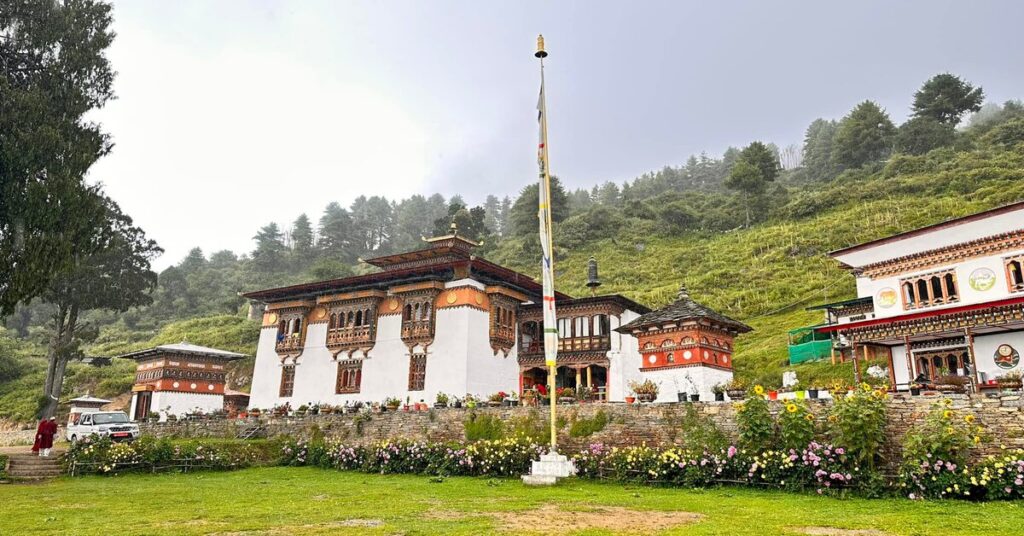
10. Dokhachu Goenpa, Chhukha
Dokhachu Goenpa, also known as Ekajati Lhakhang, is a significant temple located in Chhukha, founded in 1650 by Lama Choeje Thinley Jamtsho. Nestled at an elevation of 3,048 meters, it is renowned as the abode of the wish-granting goddess Ekajati and is a popular pilgrimage site for those seeking blessings for visas and other personal wishes. The temple features a sacred statue of Ekajati discovered by Terton Drukda Dorji from Tumdra Amai Nye.
Visitors can explore various sacred relics, including statues of Guru Rinpoche and the Three Buddhas of Three Eras. The annual festival dedicated to Aum Ekajati occurs from the 13th to the 15th day of the fourth month in the Bhutanese lunar calendar, offering public access to the temple’s relics. Dokhachu Goenpa is accessible via a one-hour drive from Thimphu, making it an essential stop for spiritual seekers in Bhutan.
Read More: Dokhachu Goenpa, a Temple of Wish-granting goddess Ekajati
Conclusion
Bhutan’s monasteries and temples are more than just architectural marvels—they are the heart of the country’s spiritual and cultural identity. These sacred temples, with their rich histories, breathtaking locations, and deep-rooted Buddhist traditions, offer visitors a unique blend of serenity, learning, and cultural immersion. Whether you seek spiritual enlightenment, a peaceful retreat, or a deeper appreciation of Bhutan’s heritage, exploring these temples will provide an unforgettable experience. A journey through Bhutan’s sacred temples is not just a pilgrimage—it’s an opportunity to connect with a land where spirituality and tradition thrive in harmony with nature. You can visit the famous temples in Bhutan with the Bhutan Pilgrimage Package.
Enjoyed reading this blog?

